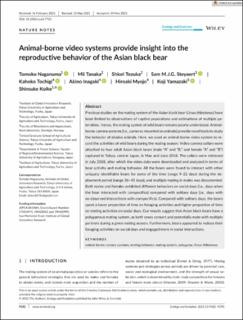| dc.contributor.author | Naganuma, Tomoko | |
| dc.contributor.author | Tanaka, Mii | |
| dc.contributor.author | Tezuka, Shiori | |
| dc.contributor.author | Steyaert, Sam | |
| dc.contributor.author | Tochigi, Kahoko | |
| dc.contributor.author | Inagaki, Akino | |
| dc.contributor.author | Myojo, Hiroaki | |
| dc.contributor.author | Yamazaki, Koji | |
| dc.contributor.author | Koike, Shinsuke | |
| dc.date.accessioned | 2022-03-04T13:59:03Z | |
| dc.date.available | 2022-03-04T13:59:03Z | |
| dc.date.created | 2022-01-17T13:41:16Z | |
| dc.date.issued | 2021 | |
| dc.identifier.citation | Naganuma, T., Tanaka, M., Tezuka, S., Steyaert, S. M. J. G., Tochigi, K., Inagaki, A., Myojo, H., Yamazaki, K. & Koike, S. (2021). Animal-borne video systems provide insight into the reproductive behavior of the Asian black bear. Ecology and Evolution, 11(14), 9182-9190. doi: | en_US |
| dc.identifier.issn | 2045-7758 | |
| dc.identifier.uri | https://hdl.handle.net/11250/2983217 | |
| dc.description.abstract | Previous studies on the mating system of the Asian black bear (Ursus thibetanus) have been limited to observations of captive populations and estimations of multiple paternities. Hence, the mating system of wild bears remains poorly understood. Animal-borne camera systems (i.e., cameras mounted on animals) provide novel tools to study the behavior of elusive animals. Here, we used an animal-borne video system to record the activities of wild bears during the mating season. Video camera collars were attached to four adult Asian black bears (male “A” and “B,” and female “A” and “B”) captured in Tokyo, central Japan, in May and June 2018. The collars were retrieved in July 2018, after which the video data were downloaded and analyzed in terms of bear activity and mating behavior. All the bears were found to interact with other uniquely identifiable bears for some of the time (range 9–22 days) during the deployment period (range 36–45 days), and multiple mating in males was documented. Both males and females exhibited different behaviors on social days (i.e., days when the bear interacted with conspecifics) compared with solitary days (i.e., days with no observed interactions with conspecifics). Compared with solitary days, the bears spent a lower proportion of time on foraging activities and higher proportion of time on resting activities on social days. Our results suggest that Asian black bears have a polygamous mating system, as both sexes consort and potentially mate with multiple partners during a given mating season. Furthermore, bears appeared to reduce their foraging activities on social days and engaged more in social interactions. | en_US |
| dc.language.iso | eng | en_US |
| dc.publisher | Wiley | en_US |
| dc.rights | Navngivelse 4.0 Internasjonal | * |
| dc.rights.uri | http://creativecommons.org/licenses/by/4.0/deed.no | * |
| dc.title | Animal-borne video systems provide insight into the reproductive behavior of the Asian black bear | en_US |
| dc.type | Peer reviewed | en_US |
| dc.type | Journal article | en_US |
| dc.description.version | publishedVersion | en_US |
| dc.rights.holder | © 2021 The Author(s) | en_US |
| dc.subject.nsi | VDP::Matematikk og Naturvitenskap: 400::Zoologiske og botaniske fag: 480::Etologi: 485 | en_US |
| dc.source.pagenumber | 9182-9190 | en_US |
| dc.source.volume | 11 | en_US |
| dc.source.journal | Ecology and Evolution | en_US |
| dc.source.issue | 14 | en_US |
| dc.identifier.doi | 10.1002/ece3.7722 | |
| dc.identifier.cristin | 1982577 | |

